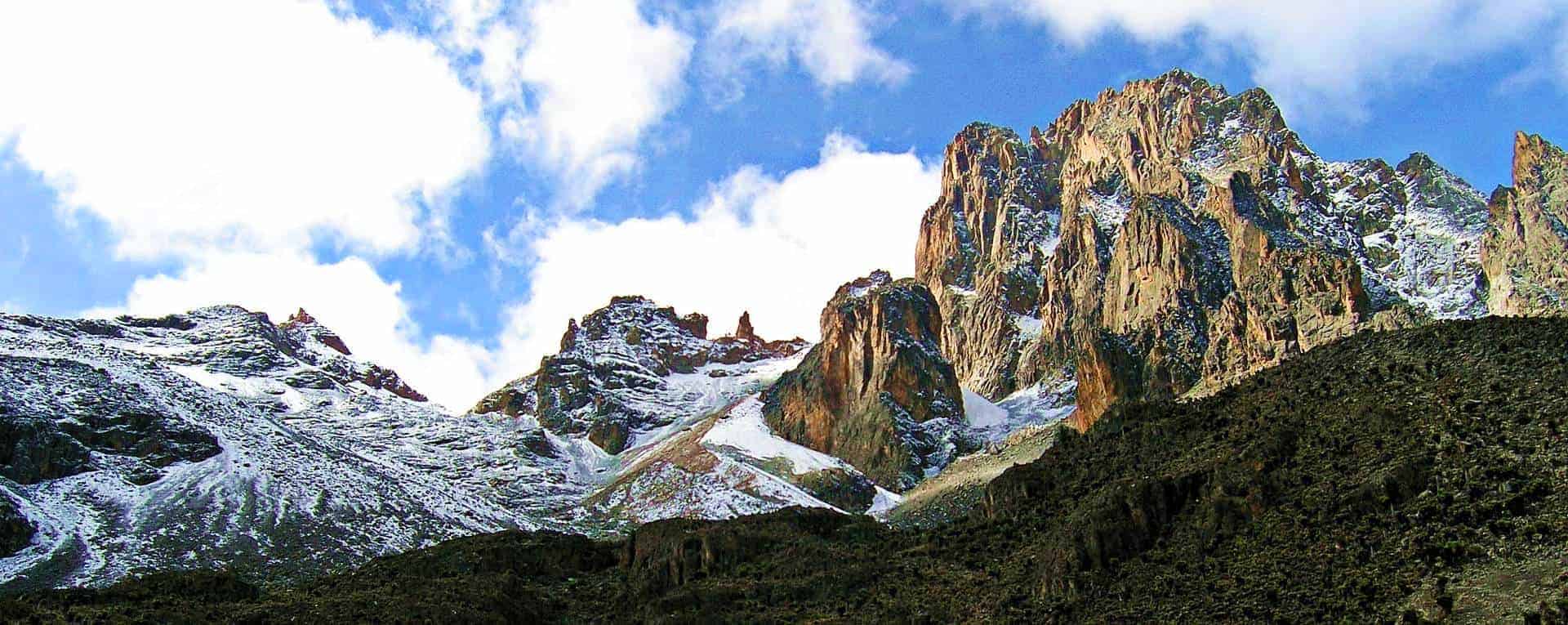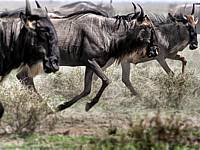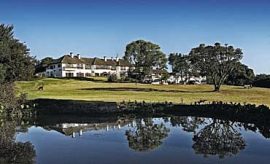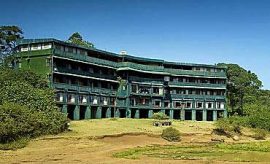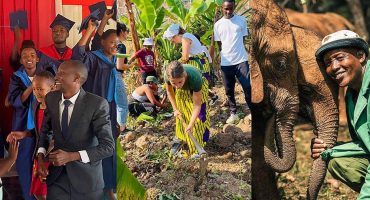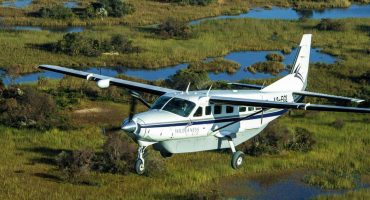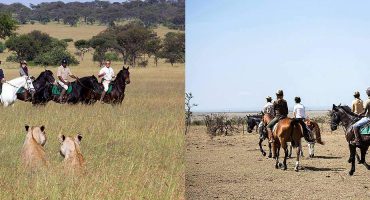CLIMBING MOUNT KENYA WITH AFRICANMECCA
Review Our Recommended 7 Days Mount Kenya Climb Itinerary
After Kilimanjaro, Mount Kenya in the eastern Great Rift Valley is the second highest mountain in Africa. Like Kili, it is an eroded stratovolcano with glaciers on its highest peaks, but unlike its higher sibling in Tanzania, only Point Lenana at 4985 meters (16355 feet) is accessible to trekkers as the lesser of the tri-peaks.The higher peaks, Batian, 5199 meters (17057 feet) and Nelion, 5188 meters (17021 feet) are technical vertical climbs requiring Class 5 technical climbing skills. AfricanMecca Safaris offer guided trails to Lenana Peak, often as acclimatization trips before attempting the Kilimanjaro climb, but we advise teaming up with specialist rock climbing guides to ascend higher, unless Class 5 clients with known expertise make special requests.
Situated east of the Great Rift Valley by the equator and 175 kilometers north-east of Nairobi, Mount Kenya National Park is reached by road or air through the Nanyuki Airstrip. The surrounding wilderness, spectacular and picturesque, was designated in 1997 as a UNESCO World Heritage Site of 715 square kilometers (276 square miles).
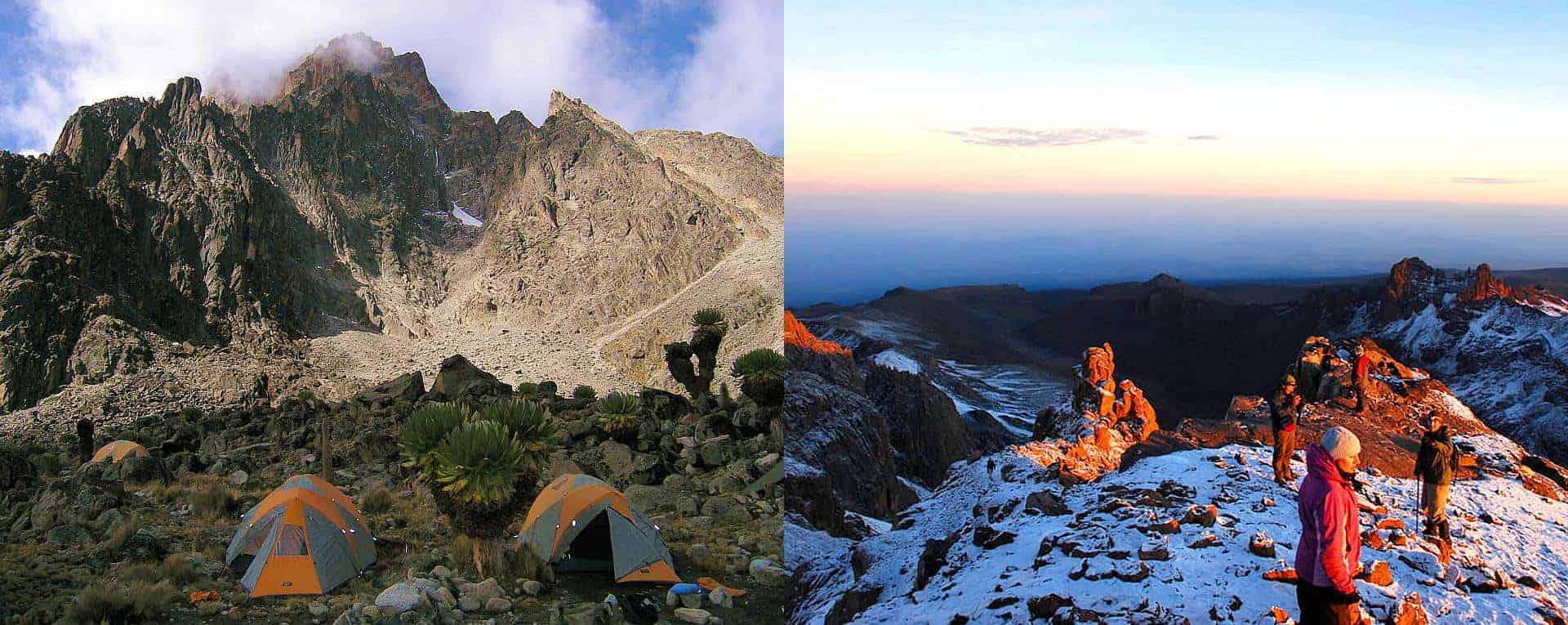
Mt. Kenya is not as celebrated an African branded mountain destination as Kilimanjaro, and advantageously, it receives fewer visitors thus preserving its wilderness ambience to a greater extent. The varied glaciers descending eroded valleys from the summit are the source of Kenya's major rivers the Ewaso Nyiro and the Tana River, the lengthiest in Kenya.
Water cascades from Afro-alpine tundra and moorland through bands of different types of bamboo, softwood and hardwood forest to farmland on the lower slopes where the Kikuyu people thrive. They saw the mountain as the home of their God, a taboo place to which rare sacrificial pilgrimages were made.
They described the mountain as resembling the distinctive male ostrich with its black and white plumage, because of its dark woodland and snowy cap. Sadly, the glaciers are dwindling as less snow accumulates each year and are expected to disappear with the rise in climate change.
There are 81 species of floras including giant senecios and lobelias to be found rarely else in the world and fauna (notably the rock hyrax, diminutive relative of the mighty elephant) which can be found when trekking on Mount Kenya. The common duiker is able to live here. The groove-toothed rat burrows into the giant senecios for insulation and the Mount Kenya mole-rat builds mole-hill mounds.
Extremely elusive leopards are also resident in the Afro-alpine zone. Several bird species including sunbirds, alpine or moorland chats and starlings pollinate the flowers while augur buzzards and massive lammergeier circle overhead. Verreaux's eagle hunts the hyraxes as you scale Mt. Kenya.
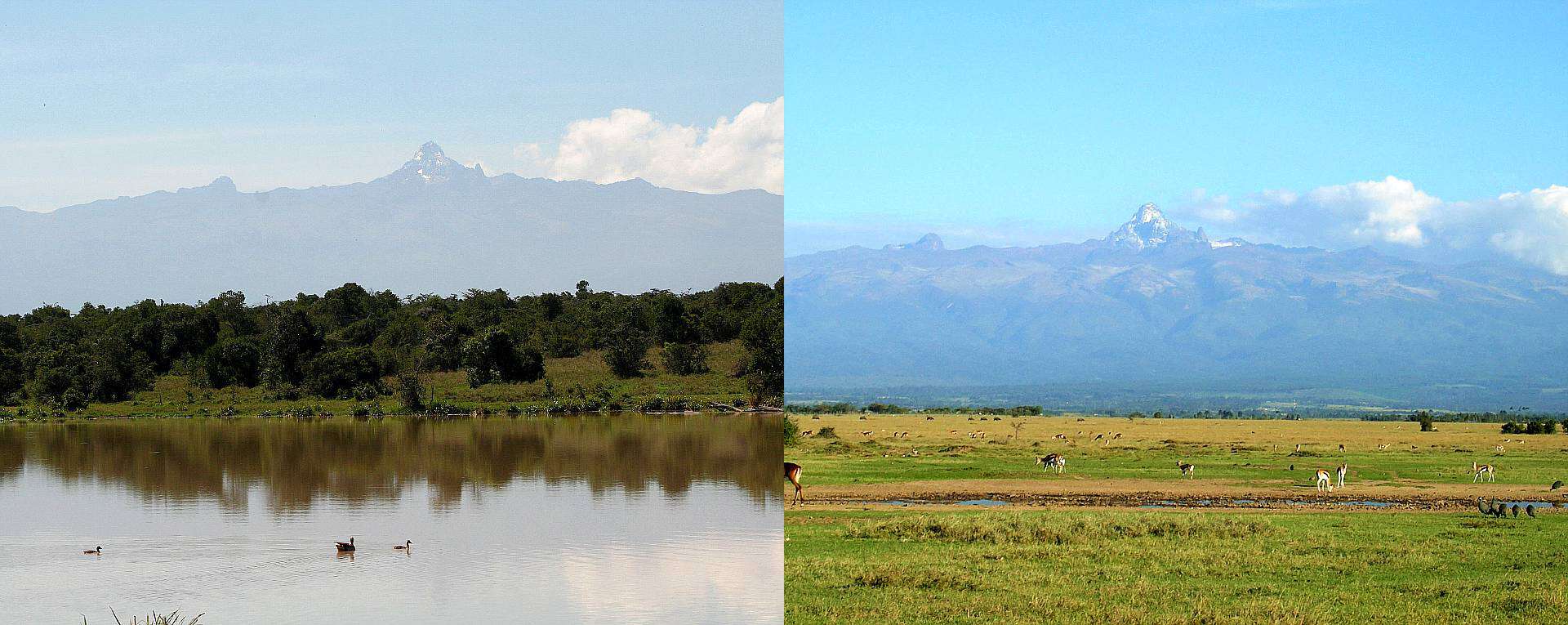
Lower slopes host hyena, buffalo, secretive leopards and civets that are not easily spotted in thick forest. Lower down, elephant, waterbuck, bushbuck, colobus and sykes monkeys are also present (read more on AfricanMecca safari experiences available at the Mount Kenya foothills). Many yesteryear attempt to hike the mountain failed since it presented some of the greatest rock and ice climbing challenges in Africa.
One ill-equipped party of escaped WWII prisoners who made the attempt 1943 were defeated by starvation. Although over 15000 attempts are made each year, not more than 100 climbers succeed in climbing both Mount Kenya’s higher two peaks. Less than half make it to the lesser third peak.
Climate change is affecting seasonal weather patterns, but it is still considered safest to make your Mount Kenya trekking trip with AfricanMecca (view itinerary) in the hot dry, between January and February; or from cool July to October when daytime temperatures are warm, around 70 F (21 C) to 77 F (25 C) degrees on the lower slopes to 5 C (41 F) as you ascend higher, leading up to below freezing temperatures at higher altitudes. Generally, it rains end of March, April, May to most parts of June and again around the end of October to November and December, making ice-climbing hazardous and bringing danger of rock falls.
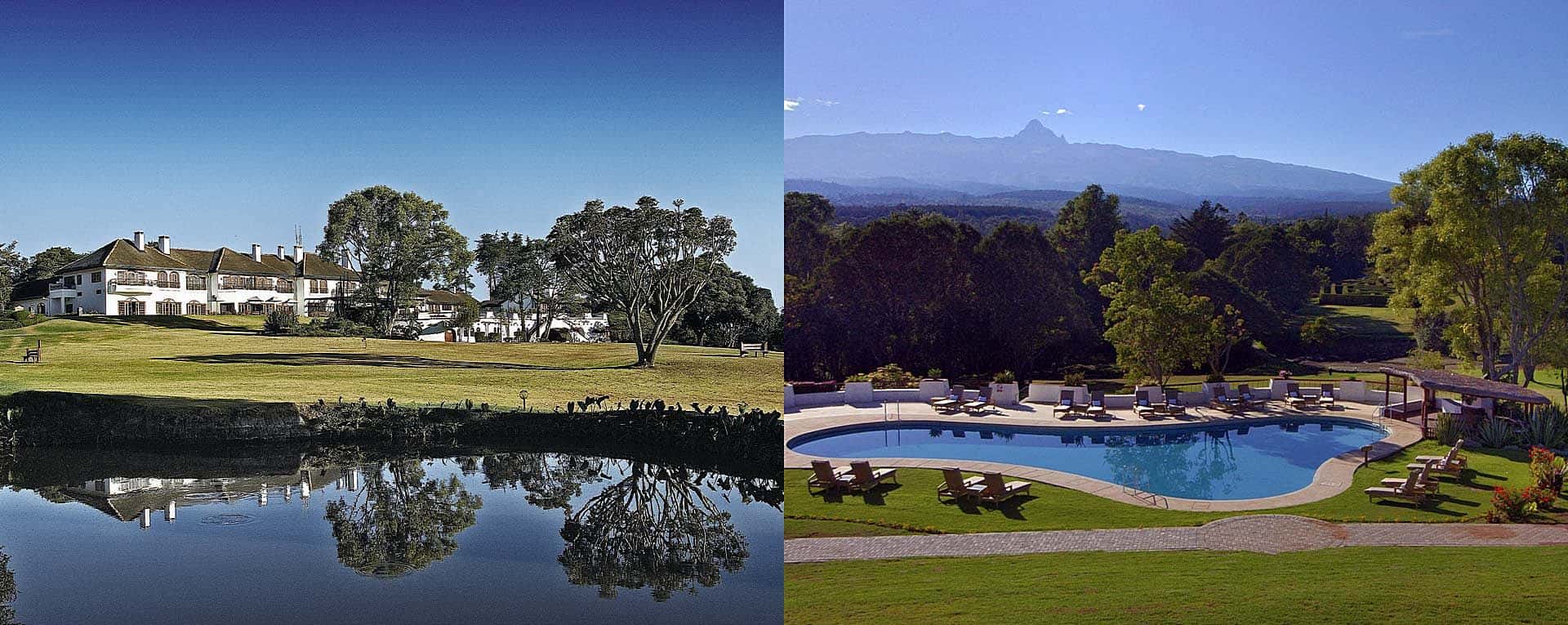
Around the end of December, temperatures increase with high humidity on lower slopes, making for exhausting conditions, although there is more chance of clear skies for superlative photography on moonlit nights when ascending Mt. Kenya. Expect some showers even during the dry period since central Kenya has slightly more rains compared to other regions in Kenya. From the dense forest of the lower slopes, it is exhilarating to emerge onto the vast alpine moorland as you trek on Mount Kenya, with breathtakingly beautiful spires of giant lobelia, their scaled or furry flower heads reaching skywards from sheaves of sword-like lower leaves, or the architectural cabbage candelabra forms of monstrous alien senecio.
This is where you need to watch for symptoms of altitude sickness (see Kilimanjaro guide), since it is possible to reach threatening altitudes on your mountain tour of Kenya. It is wiser to take your time and spend an extra day acclimatizing around 4000 meters on the upper slopes to avoid trying to summit with symptoms of altitude sickness: a blinding headache, nausea and acute shortage of breath which can affect even the fittest trekkers if they gain altitude too fast. From Lenana Peak itself, the view is unbelievable, whenever it is visible through rolling clouds of thick, cotton wool mist which often even hide the higher summits. Sunrise from the peak is an utterly unforgettable African mountain holiday experience.
AfricanMecca provides an experienced and professional trekking crew for your Mt. Kenya highlands trip comprising a guide, a cook, a personal porter for each trekker and one for equipments. It is essential to have a knowledgeable and skillful guide on Mount Kenya to protect you from your own enthusiasm as well as to encourage you, and explain the significance of everything you see around you as you soar. The Kenyan Wildlife Service requires that all guides and porters are trained, licensed and qualified in their knowledge of local conditions, flora and fauna and geological formations, and in the monitoring, recognition and treatment of high altitude sickness.
AFRICANMECCA REVIEWS
What are our Customers saying about us? READ MORE REVIEWS
Dear Raza, You turned our dream into a reality. Our honeymoon and wedding in Kenya was so much more than we hoped for. We've never in our wildest dreams thought a vacation could be so perfect...
Mrs Annemarie Bain, Post Production Producer, Maury Show NBC Studios - New York, United States
To sum it up, it was awesome! The accommodations were beautiful, the food was great, and the people of Kenya were warm and friendly. I would give an A+ to the overall rating of this safari trip. Thank you....
Sharon Kolodziejski & Family - Michigan, United States
We are writing to you on our return to say what a marvellous job AfricanMecca did for us on our holiday in Kenya. All the arrangements you made went like clockwork. We are already recommending you to friends.
Liz and Nigel Barnes - West Sussex, United Kingdom
Our Best Of Kenya Tier I safari was really wonderful. Everything was perfect. Excellent top notch service from AfricanMecca! Thanks very much for making our trip really memorable.
Lorna Mata - Ottawa, Canada
Dear AfricanMecca, I could not think of any other better way to tell you about our superb safari that you organized in Kenya than to send you my 11 year old's safari Journal..Thank you
Zahira Hassanali & Family - Long Island - New York, United States
Hi Raza, I wanted to let you know trip was very well arranged; AfricanMecca's dealings were professional, informative and particular. Governors Il Moran and Mount Kenya Safari Club were great! Thank you.
Gurdeep Singh Bedi - New Delhi, India
Dear Raza, Just a note to let you know that my daughter and I had a wonderful time in Kenya. I fell in love with your beautiful country. You certainly lived up to your commitment of superb service.
Patricia Young - Universal Music Group - California, United States
EAST AFRICA SAFARI BOOKING TRIP IDEA FOR MOUNT KENYA IN CENTRAL KENYA
When visiting Mount Kenya National Park, we recommend combining your safari to Masai Mara for the wildebeest migration, Amboseli, Samburu or Laikipia - Lewa, Nakuru, Elementaita, and Naivasha - Great Rift Valley Lakes.
You may optionally extend out to other wilderness areas of Meru, Chyulu Hills or Tsavo East - Tsavo West for an offbeat wildlife tour.
You can end your vacation at the Indian Ocean for a beach vacation and Swahili cultural tour on the exotic spice island of Zanzibar, Lamu, or Mombasa.
Best Safari Planning Ideas & Trip Experiences For Kenya
Below are guide references on how to plan each of the below safari experience in Kenya. Alternatively, go to the summary section for a quick overview of each trip planning experience.1. How To Plan Kenya Safari Trips? (Summary)
2. Wildlife Safari Trip Planning Guide For Kenya
3. Private & Tailor-Made Safaris Trip Planning Guide For Kenya
4. Honeymoon Safaris Trip Planning Guide For Kenya
5. Family Safaris Trip Planning Guide For Kenya
6. Luxury Safaris Trip Planning Guide For Kenya
7. Photo Safaris Trip Planning Guide For Kenya
8. Cultural Safaris Trip Planning Guide For Kenya
9. Primate Safaris Trip Planning Guide For Kenya
10. Hike, Trek & Bush Walk Safaris Trip Planning Guide For Kenya
11. Birding Safaris Trip Planning Guide For Kenya
12. Horseback Riding Safaris Trip Planning Guide For Kenya
13. Balloon Safaris Trip Planning Guide For Kenya
14. Wedding Safaris Trip Planning Guide For Kenya
15. Bush & Beach Safaris Trip Planning Guide For Kenya
READ MORERead More +
GUIDE ON MOUNT KENYA PARK
Celebrating Kenya's iconic landmark, Mount Kenya National Park offers a distinct highlands tour to the discerning AfricanMecca guest, from forest walks, peak climbs to lodge game viewing and more.
Read More +
WHERE TO STAY IN MOUNT KENYA
Fairmont Mount Kenya Safari Club is located outside the park borders near Nanyuki while Serena Mountain Lodge is sought by guests who want to stay inside the park amidst the forest wilderness.
Read More +
SAFARI & TOUR IN MOUNT KENYA
The extraordinary beauty of Mount Kenya inspires you to venture into the wilderness. While safari game drives are not allowed due to its fragile ecology, you do enjoy nature walks in the foothills.
Read More +
BEST TIME TO VISIT MOUNT KENYA
The weather at Mount Kenya National Park consistently offers guests a unique African highlands safari experience at any time of year. This park experiences two dry seasons and two rainy seasons.
MOUNT KENYA PARK SAFARI & TOUR PLANNING DETAILS
Kickstart Your Safari Planning
ARE YOU PLANNING TO BOOK AN AFRICAN SAFARI TO MOUNT KENYA IN KENYA?
Do You Need Knowledgeable, Experienced & Specialist Guidance For Your Travels In Mount Kenya ? Let Us Help Plan Your Trip Itinerary Correctly
CONTACT AN AFRICA TRAVEL EXPERT ON MOUNT KENYA NATIONAL PARKEXPLORE MORE ON MOUNT KENYA NATIONAL PARK IN KENYA
HAVE YOU VISITED MOUNT KENYA FOR AN AFRICA SAFARI IN KENYA?
Write A Travel Or Tourist Trip Review To Share Your Experiences
WRITE MOUNT KENYA REVIEWAMS BLOG
VIEW ALL -- 24 December 2024 by AfricanMecca Safaris, in Blog For AfricanMecca Safaris,Safari Planning Blog Posts - AfricanMecca Safaris
What AfricanMecca Accomplished In 2024
What AfricanMecca Accomplished In 2024 Published By AfricanMecca Safaris | Blog ...READ MORE + - 26 October 2017 by AfricanMecca Safaris, in Blog For AfricanMecca Safaris,Safari Planning Blog Posts - AfricanMecca Safaris
Baggage Guidance & Restrictions On Flying Safaris In Africa
Baggage Guidance & Restrictions On Flying Safaris In Africa Published By Afr...READ MORE + - 07 June 2017 by AfricanMecca Safaris, in Blog For AfricanMecca Safaris,Latest Kenya Blog Posts From AfricanMecca Safaris,Safari Planning Blog Posts - AfricanMecca Safaris
Masai Mara Horseback Riding Safari In Kenya With AfricanMecca
Masai Mara Horseback Riding Safari In Kenya Published By AfricanMecca Safaris | ...READ MORE +

